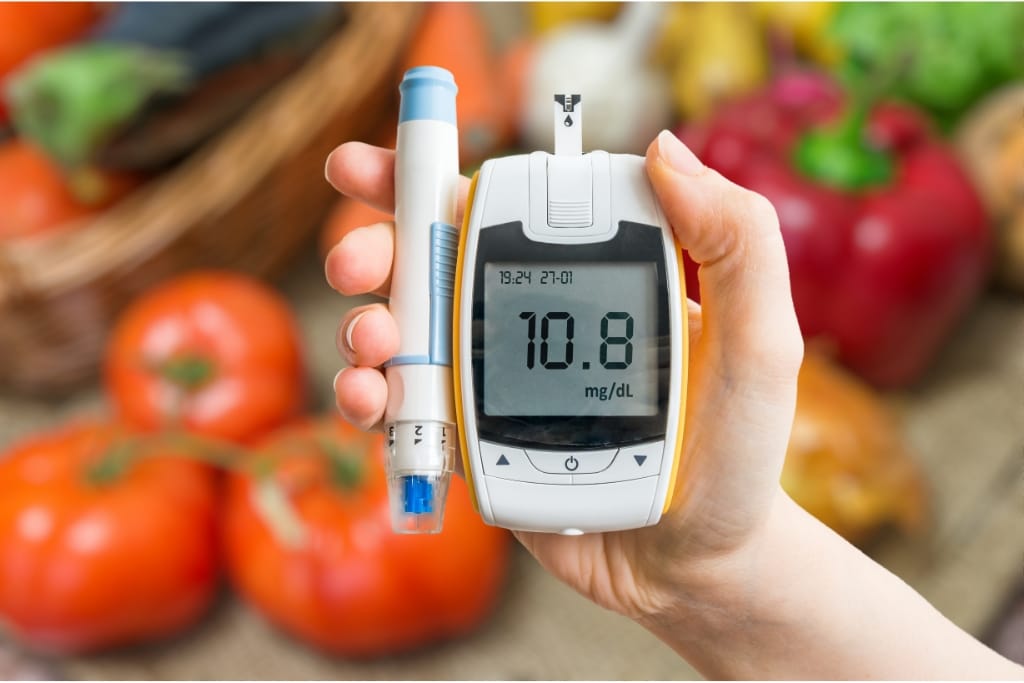For people with type 2 diabetes, it's important to maintain a healthy diet to manage blood sugar levels and prevent potential complications.
However, this can be easier said than done. With so many different nutrition strategies and conflicting information out there, it can be difficult to know where to start.
To make it easier for you, we've compiled 10 diet tips for type 2 diabetes that you can start implementing today.
1)) Focus On Whole Foods
When it comes to managing type 2 diabetes, a diet that is rich in whole, unprocessed foods is key.
These foods contain essential nutrients that your body needs to function optimally, without the added sugars and preservatives found in many processed foods.
Focus on incorporating fresh fruits and vegetables, lean protein sources, and high-fiber whole grains into your diet.
Practical Tips for Focusing on Whole Foods:
- Explore the Perimeter: When grocery shopping, stick to the perimeter of the store. This is where you'll usually find fresh produce, lean proteins, and whole grains.
- Batch Cooking: Prepare meals in bulk using whole food ingredients, then freeze them. This helps ensure you always have a healthy, home-cooked meal ready.
- Reading Labels: Always read the nutritional information on the back of food packages. Avoid items with a long list of ingredients, especially those you can't pronounce. The fewer ingredients, the better.
Focusing on whole foods is a critical aspect of managing type 2 diabetes.
It requires a conscious effort to understand food choices, read labels, and prepare meals.
Whole foods provide necessary nutrients without the risks of added sugars and preservatives, contributing to better blood sugar control and overall health.
By integrating these tips into your daily routine, you're taking an essential and empowered step toward managing your diabetes effectively.
2)) Limit Your Intake Of Refined Carbohydrates
Carbohydrates are an essential macronutrient, but not all carbs are created equal.
Refined carbohydrates, such as white bread and sugary snacks, are quickly broken down into sugar in your body and can lead to spikes in blood sugar levels.
Focus on incorporating complex carbohydrates, such as whole grains, into your diet instead.
Practical Tips to Limit Your Intake of Refined Carbohydrates:
- Swap for Whole Grains: Wherever possible, substitute refined grains (white bread, pasta) with whole grain alternatives. These are not only more nutritious but also take longer to digest, helping to prevent sudden blood sugar spikes.
- Limit Sugary Drinks: Sugary drinks are a significant source of refined carbohydrates. Opt for water, unsweetened tea, or infused water to quench your thirst.
- Satisfy Sweet Cravings Wisely: If you crave something sweet, choose fruits over sweets or pastries. Fruits contain natural sugars and are packed with fiber and essential nutrients.
Limiting your intake of refined carbohydrates is a significant step in managing type 2 diabetes.
It's essential to recognize the impact that certain carbohydrates can have on your blood sugar levels and to make mindful decisions about your carbohydrate sources.
By swapping out refined grains for whole grains, reducing sugary drink consumption, and choosing healthier alternatives when cravings strike, you can better control your blood sugar levels and improve your overall health.
Every small change counts and contributes to a healthier you.
3)) Choose Healthy Fats
Fat is an essential macronutrient that your body needs for energy and to absorb certain vitamins.
However, not all fats are created equal. Focus on incorporating healthy fats, such as those found in nuts, seeds, and fatty fish, into your diet while limiting your intake of saturated and trans fats.
Practical Tips to Choose Healthy Fats:
- Incorporate Fatty Fish: Try to include fatty fish like salmon, mackerel, or tuna in your meals at least twice a week. They are rich in omega-3 fatty acids, which are beneficial for heart health.
- Opt for Nuts and Seeds: Nuts and seeds are excellent sources of monounsaturated fats. Sprinkle them on your salads, or oatmeal, or just have them as a snack.
- Use Healthy Oils for Cooking: Instead of using butter or lard for cooking, opt for oils that are high in monounsaturated or polyunsaturated fats, such as olive oil.
Choosing healthy fats over unhealthy ones is a key aspect of a diet designed to manage type 2 diabetes.
Incorporating foods rich in monounsaturated and polyunsaturated fats, like fatty fish, nuts, and seeds, and using healthy oils for cooking can significantly improve your overall health.
It's not just about avoiding fat; it's about making smarter choices about the types of fat you consume.
These tips are not only beneficial for blood sugar control but also for heart health. Every small dietary change you make in the direction of healthier choices is a victory.
Pro-Tip: Invest in Nature's Sunshine Super Omega-3 EPA 180 Softgels: As a person managing diabetes, incorporating Omega-3 supplements in your diet can be highly beneficial. Nature's Sunshine Super Omega-3 EPA Softgels are a rich source of eicosapentaenoic acid (EPA) and docosahexaenoic acid (DHA), fatty acids that have been linked to improved cardiovascular and brain health. Omega-3 fatty acids also play a crucial role in reducing inflammation, which is beneficial for managing diabetes complications. By investing in Nature's Sunshine Super Omega-3 EPA 180 Softgels, you're making a valuable addition to your diabetes management regimen and overall health.
4)) Watch Your Portion Sizes
Portion control is essential when managing type 2 diabetes. When you eat too much, even healthy foods, your blood sugar levels can spike.
Try using smaller plates, measuring out your portions, and paying attention to your body's hunger and fullness cues to help you practice portion control.
Practical Tips to Watch Your Portion Sizes:
- Use Smaller Plates: Using smaller plates can trick your brain into thinking you're eating more than you are, helping you to feel satisfied with less.
- Measure Your Portions: Use measuring cups or a food scale to ensure you're not overestimating portion sizes.
- Listen to Your Body: Pay attention to your hunger and fullness cues. Eat slowly and stop eating when you feel satisfied, not necessarily when your plate is empty.
Mastering portion control is crucial in managing type 2 diabetes. While it's important to focus on what you eat, how much you eat cannot be overlooked.
By using smaller plates, accurately measuring your food, and tuning into your body's signals, you can prevent overeating and avoid unnecessary blood sugar spikes.
It's not just about eating less but eating right. Every step towards portion control is a stride towards a healthier you.
5)) Stay Hydrated
Drinking plenty of water is important for everyone, especially for people with type 2 diabetes.
When you're dehydrated, your blood sugar levels can increase, so it's important to stay adequately hydrated throughout the day. Aim for at least 8 cups of water per day.
Practical Tips to Stay Hydrated:
- Carry a Water Bottle: Having a water bottle with you at all times can serve as a reminder to drink water throughout the day.
- Drink a Glass of Water with Each Meal: Make it a habit to drink a glass of water at the start of every meal. This will not only help with digestion but also ensure regular water intake.
- Flavor Your Water: If you find plain water boring, flavor your water with a slice of lemon, cucumber, or a splash of fruit juice. This may make it more enticing and help increase your daily water intake.
Maintaining proper hydration is a vital, yet often overlooked, aspect of managing type 2 diabetes.
By making simple changes like carrying a water bottle, incorporating a glass of water with each meal, and adding a hint of flavor to your water, you can significantly improve your daily water intake.
When you're adequately hydrated, your blood sugar levels are better regulated.
It's a small step that can make a big difference in your overall health and well-being.
6)) Choose Healthy Snacks
Snacks can be a great way to help manage hunger and prevent blood sugar spikes, but it's important to choose healthy snacks that won't sabotage your efforts.
Focus on snacks that are high in fiber, protein, and healthy fats, such as fresh fruit with nuts or Greek yogurt with berries.
Practical Tips to Choose Healthy Snacks:
- Opt for Protein-Rich Snacks: Snacks enriched with protein, like Greek yogurt, cottage cheese, or hard-boiled eggs, can keep you satisfied for a longer time while balancing your blood sugar levels.
- Choose Fiber-Filled Fruits and Veggies: Eating fresh fruits and vegetables as snacks not only increases your fiber intake which is good for blood sugar control, but also provides important vitamins and minerals.
- Include Healthy Fats: Snacks that contain healthy fats, such as nuts and seeds, or avocado, can slow the absorption of sugar into your blood and prevent spikes.
Choosing the right snacks is an important part of managing type 2 diabetes.
Opting for snacks that are high in protein, fiber, and healthy fats can help to keep your blood sugar levels steady between meals.
By selecting snacks like Greek yogurt, fresh fruits and vegetables, and nuts or seeds, you're not only curbing your hunger but also promoting better overall health.
Every healthy choice you make can have a positive impact on your diabetes management.
7)) Don't Skip Meals
Skipping meals can lead to drops in blood sugar levels and cause you to overeat later in the day.
It's important to eat regular meals throughout the day to help keep your blood sugar levels stable and prevent overeating.
Practical Tips to Avoid Skipping Meals:
- Plan Your Meals: Having a meal plan can help you stick to regular eating times. This also ensures you have the right ingredients on hand, minimizing the chances of skipping meals.
- Eat Balanced Meals: Include a mix of protein, fiber, and healthy fats in your meals. This can help you feel satisfied for longer and reduce the temptation to skip meals.
- Use Reminders: Set reminders on your phone or computer to alert you when it's time to eat. This can be particularly helpful if you tend to forget meals when you're busy.
Adhering to a regular eating schedule is crucial in maintaining stable blood sugar levels and preventing overeating.
Implementing strategies such as meal planning, eating balanced meals, and setting up meal reminders can significantly reduce the likelihood of skipping meals.
Consistency in meal times is not just about discipline but an integral part of effective diabetes management.
Each meal you don't skip is a step further in your journey towards better health.
8)) Limit Your Intake Of Sugary Beverages
Sodas, juices, and other sugary beverages can quickly add up in calories and sugar, leading to spikes in blood sugar levels.
It's important to limit your intake of these beverages and focus on drinking water, unsweetened tea, or other low-calorie beverages instead.
Practical Tips to Limit Your Intake of Sugary Beverages:
- Swap for Water: Water is the healthiest drink choice and vital for your body's hydration. Try substituting one sugary drink daily with a glass of water and gradually increase this over time.
- Try Unsweetened Drinks: Opt for drinks without added sugars, such as unsweetened tea or coffee. These can provide flavor without the sugar content.
- Read Labels Carefully: Always check the nutritional labels of beverages. Many drinks marketed as healthy can still contain high amounts of sugar. Understanding labels can help you make better choices.
Reducing your intake of sugary beverages is a critical step in managing type 2 diabetes.
By swapping out sugary drinks with water, opting for unsweetened alternatives, and being mindful of reading labels, you can significantly decrease your sugar intake.
Trading sugary drinks for healthier options not only helps to regulate your blood sugar levels but also contributes positively to your overall health.
Each sip towards healthier beverages is a stride in your journey towards better diabetes management.
9)) Keep Healthy Snacks On Hand
Having healthy snacks on hand can help prevent you from making less healthy choices when hunger strikes.
Try keeping a supply of fresh fruit, nuts, or low-fat yogurt on hand for when you need a quick and healthy snack.
Practical Tips to Keep Healthy Snacks On Hand:
- Shop Smart: When grocery shopping, focus on buying healthy snacks like fruits, nuts, or low-fat yogurt. Having these on hand will make it easier to make healthier choices when hunger strikes.
- Pre-Portion Your Snacks: Prepare and portion out your snacks in advance. This not only ensures that you have a quick, healthy option when you need it but also helps with portion control.
- Invest in Good Storage: Using containers or zip-lock bags can help to keep your snacks fresh and easy to access. This can be particularly helpful for snacks like cut fruits or vegetables.
Maintaining a supply of healthy snacks at your disposal is a practical and effective strategy for managing type 2 diabetes.
By shopping smart, pre-portioning your snacks, and investing in good storage, you can make it easier to reach for nutritious options when hunger strikes.
Every healthy snack you choose is a proactive decision that contributes to better diabetes management and overall health.
10)) Keep A Food Journal
Tracking your meals and blood sugar levels can help you understand what works best for your body and identify potential triggers.
Practical Tips to Maintain a Food Journal:
- Record Consistently: Make sure to write down what you eat immediately after each meal, to ensure accuracy. Also note down your blood sugar levels alongside, to draw correlations.
- Include Details: Apart from what you eat, also note down quantities, timing, and how you felt before and after eating. This can provide valuable insights into how different food affects you.
- Review Regularly: Don’t just fill the journal, make it a point to review it regularly. This can help identify patterns and make necessary dietary adjustments.
Maintaining a food journal is a powerful tool in managing type 2 diabetes.
By recording consistently, including pertinent details, and reviewing your entries regularly, you can gain valuable insights into how your body responds to different foods.
This active engagement with your dietary habits helps you identify patterns, make necessary adjustments, and take control of your health.
Your food journal is more than just a record; it's a proactive step towards better diabetes management and overall well-being.
Pro-Tip: Invest in a Diabetic Food Journal: Remember that managing type 2 diabetes goes beyond counting carbs; it's about understanding how your body responds to different foods and portion sizes. A diabetic food journal can serve as an effective tool for tracking your meals, snacks, and blood sugar levels, allowing you to identify patterns and triggers. The act of logging what you eat can heighten your awareness of your eating habits, providing valuable insights that can guide your dietary decisions. Investing in a diabetic food journal is, therefore, a crucial step toward proactive diabetes management and overall health.
Conclusion
Eating a healthy diet is important for managing type 2 diabetes and preventing potential complications.
By focusing on whole foods, limiting your intake of refined carbohydrates, choosing healthy fats, watching your portion sizes, and staying hydrated, you can help keep your blood sugar levels stable and prevent overeating.
Additionally, practicing good snacking habits, not skipping meals, limiting your intake of sugary beverages, and keeping healthy snacks on hand can help make healthy choices easier.
By practicing mindful eating habits, you can fully appreciate your food and make healthier choices overall.
Related Articles and Guides:
- How To Manage Type 2 Diabetes
- How To Lose Weight With Type 2 Diabetes
- How To Control Type 2 Diabetes With Diet And Exercise
- 10 FAQs About How To Control Type 2 Diabetes With Diet
- 10 Dieting Tips For People With Type 2 Diabetes
- 10 Diabetic Foot Care Tips
Download Our Free E-book!








